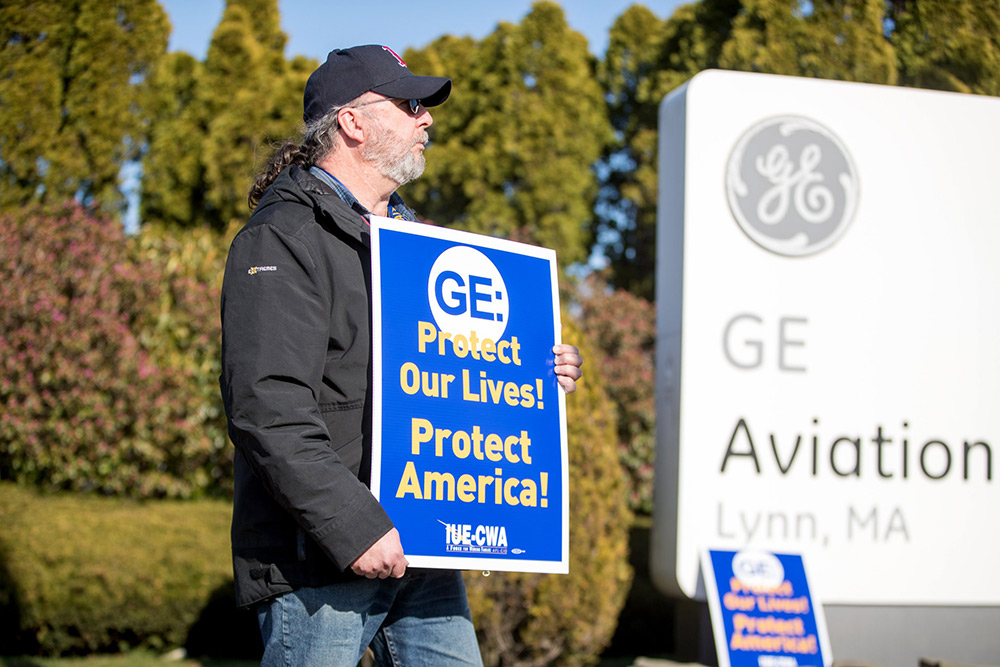
通用電氣(General Electric)最近宣布將在未來三年拆分成三家獨立公司。該公司的首席執行官拉里·卡爾普表示,“通過提高業務專注度、有針對性地進行資本配置和提高戰略靈活性,能夠推動長期增長,為客戶、投資者和員工創造價值,這將令所有人受益。”
這番陳述很值得懷疑。
很不幸的是,卡爾普一直以來只關注如何滿足投資者預期,包括由億萬富翁納爾遜·佩爾茨經營的掠奪成性的對沖基金Trian。雖然該基金持有通用電氣的少數股份,但自2015年以來,它卻對這家公司的戰略發展方向產生了巨大的影響。
Trian表示“積極支持”通用電氣的所謂轉型計劃,佩爾茨本人曾經形容通用電氣的首席執行官卡爾普是“深諳企業經營之道”的“明星”。但卡爾普和Trian Partners似乎只關心下一次大賺一筆的機會,卻沒有考慮到美國制造業的未來或者通用電氣的長遠利益。他們當然沒有想到依賴通用電氣就業崗位的員工和社區:在卡爾普和Trian的重組方案產生的破壞性影響真正顯現之前,他們可能早就已經離開了這家公司。
作為通用電氣美國工人最大的代表,我們以前看到過這種情況。
1989年,通用電氣在美國有27.7萬名員工,但到2019年只剩下7萬人。通用電氣多年來選擇離岸外包,拋棄了美國的工人和社區,導致其國內制造業務已經空有其表。
拆分的決定讓通用電氣站到了十字路口。這家有129年歷史的公司是否希望繼續40年來在美國制造業務方面的做法,縮減投資、解散工會和離岸外包?通用電氣是會繼續將全世界和美國的安全至于風險之中,還是選擇加入具有歷史意義的美國重建?
2011年,通用電氣可再生能源(GE Renewable Energy)在美國紐約州的斯克內克塔迪正式成立,該業務獲得了聯邦政府的撥款,但現在它的總部卻設在海外。2020年,通用電氣可再生能源產品的收入增長34%,但其就業崗位卻被轉移到中國、波蘭和德國。通用電氣發電和可再生能源業務被轉移到印度和越南。我們沮喪地看著通用電氣將生產線和就業崗位搬到其他國家,盡管工會一直非常有誠意地努力配合該公司,確保其未來在新綠色經濟中的盈利能力。
通用電氣依舊是全世界最大的國防承包商之一。去年,該公司從美國政府獲得超過40億美元的國防收入,但這些錢并沒有投入到美國工人、社區或工廠。2020年,通過對因新冠疫情損失業務的軍事承包商的補助計劃,通用電氣從五角大樓獲得2000萬美元補助。2020年6月,通用電氣航空(GE Aviation)通過美國聯邦政府的《冠狀病毒援助、救濟和經濟安全法案》(CARES Act)獲得7500萬美元補助。今年1月,該公司從美國國防部(Department of Defense)獲得2000萬美元撥款,用于開發高科技風力渦輪機發電機。
馬薩諸塞大學波士頓分校(University of Massachusetts, Boston)最近的報告和康奈爾大學(Cornell University)的文件顯示,通用電氣從納稅人緊急救助和政府合同中獲得巨大好處,但它仍然在繼續向海外轉移就業崗位、關閉工廠、違反對退休員工的承諾、縮減國內制造業務規模和執行其他裁員計劃,對美國工人造成無可挽回的傷害。僅過去三年,該公司的美國員工數量已經減少了47%。
在位于馬薩諸塞州林恩的工廠,技術精湛的機械師和技術人員為美國軍方生產零部件和發動機,該工廠曾經有約13000名加入工會的小時工。如今這個數字已經減少到1200人。愛迪生于1892年在斯克內克塔迪創立了通用電氣,而隨著其生產線被轉移到海外或者外包給未設立工會的工廠,當地加入工會的工人已經從最高時的30000人減少到不足800人。通用電氣在弗吉尼亞州塞勒姆的工廠曾經有3000名技術嫻熟的工人,后來減少到只有260人,到2019年被徹底關閉,導致當地曾經繁榮的社區被毀于一旦。
近幾年,通用電氣及其供應商并沒有在美國開展創新和投資,而是關閉了在弗吉尼亞州、俄亥俄州、佐治亞州、阿肯色州、南達科他州和得克薩斯州的工廠,嚴重破壞了當地的藍領工人社區,導致忠誠的員工為了維持生存苦苦掙扎。
通用電氣的經營模式過度依賴離岸外包,導致對美國電力供應和國防至關重要的產品的供應鏈變得更加脆弱。如果通用電氣希望重建更美好的美國,并最大程度提高清潔能源繁榮帶來的收入,它就必須重新投資國內具有歷史意義的制造工廠,并且進行現代化改造。
無論通用電氣最終繼續作為一家公司還是拆分成三家公司經營,都必須停止離岸外包的策略。否則就是背叛美國的工人,這將對生存日益艱難的社區造成毀滅性打擊。(財富中文網)
本文作者克里斯·謝爾頓是美國通信工人聯合會(Communications Workers of America)的主席。
翻譯:劉進龍
審校:汪皓
通用電氣(General Electric)最近宣布將在未來三年拆分成三家獨立公司。該公司的首席執行官拉里·卡爾普表示,“通過提高業務專注度、有針對性地進行資本配置和提高戰略靈活性,能夠推動長期增長,為客戶、投資者和員工創造價值,這將令所有人受益。”
這番陳述很值得懷疑。
很不幸的是,卡爾普一直以來只關注如何滿足投資者預期,包括由億萬富翁納爾遜·佩爾茨經營的掠奪成性的對沖基金Trian。雖然該基金持有通用電氣的少數股份,但自2015年以來,它卻對這家公司的戰略發展方向產生了巨大的影響。
Trian表示“積極支持”通用電氣的所謂轉型計劃,佩爾茨本人曾經形容通用電氣的首席執行官卡爾普是“深諳企業經營之道”的“明星”。但卡爾普和Trian Partners似乎只關心下一次大賺一筆的機會,卻沒有考慮到美國制造業的未來或者通用電氣的長遠利益。他們當然沒有想到依賴通用電氣就業崗位的員工和社區:在卡爾普和Trian的重組方案產生的破壞性影響真正顯現之前,他們可能早就已經離開了這家公司。
作為通用電氣美國工人最大的代表,我們以前看到過這種情況。
1989年,通用電氣在美國有27.7萬名員工,但到2019年只剩下7萬人。通用電氣多年來選擇離岸外包,拋棄了美國的工人和社區,導致其國內制造業務已經空有其表。
拆分的決定讓通用電氣站到了十字路口。這家有129年歷史的公司是否希望繼續40年來在美國制造業務方面的做法,縮減投資、解散工會和離岸外包?通用電氣是會繼續將全世界和美國的安全至于風險之中,還是選擇加入具有歷史意義的美國重建?
2011年,通用電氣可再生能源(GE Renewable Energy)在美國紐約州的斯克內克塔迪正式成立,該業務獲得了聯邦政府的撥款,但現在它的總部卻設在海外。2020年,通用電氣可再生能源產品的收入增長34%,但其就業崗位卻被轉移到中國、波蘭和德國。通用電氣發電和可再生能源業務被轉移到印度和越南。我們沮喪地看著通用電氣將生產線和就業崗位搬到其他國家,盡管工會一直非常有誠意地努力配合該公司,確保其未來在新綠色經濟中的盈利能力。
通用電氣依舊是全世界最大的國防承包商之一。去年,該公司從美國政府獲得超過40億美元的國防收入,但這些錢并沒有投入到美國工人、社區或工廠。2020年,通過對因新冠疫情損失業務的軍事承包商的補助計劃,通用電氣從五角大樓獲得2000萬美元補助。2020年6月,通用電氣航空(GE Aviation)通過美國聯邦政府的《冠狀病毒援助、救濟和經濟安全法案》(CARES Act)獲得7500萬美元補助。今年1月,該公司從美國國防部(Department of Defense)獲得2000萬美元撥款,用于開發高科技風力渦輪機發電機。
馬薩諸塞大學波士頓分校(University of Massachusetts, Boston)最近的報告和康奈爾大學(Cornell University)的文件顯示,通用電氣從納稅人緊急救助和政府合同中獲得巨大好處,但它仍然在繼續向海外轉移就業崗位、關閉工廠、違反對退休員工的承諾、縮減國內制造業務規模和執行其他裁員計劃,對美國工人造成無可挽回的傷害。僅過去三年,該公司的美國員工數量已經減少了47%。
在位于馬薩諸塞州林恩的工廠,技術精湛的機械師和技術人員為美國軍方生產零部件和發動機,該工廠曾經有約13000名加入工會的小時工。如今這個數字已經減少到1200人。愛迪生于1892年在斯克內克塔迪創立了通用電氣,而隨著其生產線被轉移到海外或者外包給未設立工會的工廠,當地加入工會的工人已經從最高時的30000人減少到不足800人。通用電氣在弗吉尼亞州塞勒姆的工廠曾經有3000名技術嫻熟的工人,后來減少到只有260人,到2019年被徹底關閉,導致當地曾經繁榮的社區被毀于一旦。
近幾年,通用電氣及其供應商并沒有在美國開展創新和投資,而是關閉了在弗吉尼亞州、俄亥俄州、佐治亞州、阿肯色州、南達科他州和得克薩斯州的工廠,嚴重破壞了當地的藍領工人社區,導致忠誠的員工為了維持生存苦苦掙扎。
通用電氣的經營模式過度依賴離岸外包,導致對美國電力供應和國防至關重要的產品的供應鏈變得更加脆弱。如果通用電氣希望重建更美好的美國,并最大程度提高清潔能源繁榮帶來的收入,它就必須重新投資國內具有歷史意義的制造工廠,并且進行現代化改造。
無論通用電氣最終繼續作為一家公司還是拆分成三家公司經營,都必須停止離岸外包的策略。否則就是背叛美國的工人,這將對生存日益艱難的社區造成毀滅性打擊。(財富中文網)
本文作者克里斯·謝爾頓是美國通信工人聯合會(Communications Workers of America)的主席。
翻譯:劉進龍
審校:汪皓
General Electric recently announced that the conglomerate will divide itself into three separate companies in the course of the next three years. CEO Larry Culp stated that “each can benefit from greater focus, tailored capital allocation, and strategic flexibility to drive long-term growth and value for customers, investors, and employees.”
That’s highly questionable.
Unfortunately, Culp has always been focused primarily on managing investor expectations, including for the predatory hedge fund run by billionaire Nelson Peltz, Trian, which has had an excessive influence on the strategic direction of the company since 2015, despite holding a minority of the stock.
Trian has stated that they “enthusiastically support” GE’s so-called transformation, and Peltz himself has described CEO Culp as a “star” who “knows how to run a business.” But it seems like Culp and Trian Partners may just be looking for the next big payday for themselves, and not looking out for the future of American manufacturing or GE’s long-term interest. They are certainly not looking out for their employees and the communities that depend on GE jobs: Culp and Trian will likely be long gone before the destructive effects of their proposed restructuring are fully felt.
As the largest representative of GE workers in the United States, we’ve seen this before.
In 1989, GE employed 277,000 workers in the U.S. In 2019, that number was only 70,000. Years of offshoring jobs and abandoning workers and communities have left GE’s domestic manufacturing footprint a shell of what it once was.
With its decision to split, GE stands at a crossroads. Does the 129-year-old institution want to continue its 40-year track record of disinvesting, de-unionizing, and offshoring its U.S. manufacturing operations? Will GE continue putting our planet and national security at risk or will it choose to be part of a historic rebuilding of America?
GE Renewable Energy launched with a federal grant in Schenectady, N.Y., in 2011, but it is now headquartered overseas. Revenue from GE’s renewable energy products was up 34% in 2020, yet jobs are being moved to China, Poland, and Germany. GE power generation and renewables work has also been moved to India and Vietnam. We have watched in frustration as GE shipped product lines and jobs overseas, despite good faith efforts by the union to work with the company to ensure a profitable future in the new green economy.
GE remains one of the largest defense contractors in the world. Last year, the company received over $4 billion in defense revenue from the U.S. government, dollars not invested in U.S. workers, communities, or facilities. It received $20 million from the Pentagon in 2020 as part of a program to aid military contractors who lost business due to the COVID-19 pandemic. GE Aviation got $75 million through the federal CARES Act in June 2020. In January, the company won a $20 million grant from the federal Department of Defense to develop high-tech wind turbine generators.
As a recent report from the University of Massachusetts, Boston, and Cornell University documents, GE has benefited mightily from taxpayer bailouts and government contracts, yet it has continued to move jobs, shutter plants, break promises to retirees, downsize domestic manufacturing, and implement other cuts that have irreparably harmed American workers. The company has slashed its U.S. workforce by 47% in just the past three years.
In Lynn, Mass., where skilled machinists and techs build components and engines for the U.S. military, there were once nearly 13,000 unionized hourly workers. Today there are merely 1,200. In Schenectady, where Edison founded GE in 1892, there are fewer than 800 unionized workers, down from a high of 30,000, as product lines have been sent overseas or outsourced to nonunion shops. A GE plant in Salem, Va., that once employed 3,000 skilled workers, was whittled down to just 260 until it was closed altogether in 2019, devastating this once-thriving community.
Rather than innovate and invest here in America, GE and its suppliers have closed plants in recent years in Virginia, Ohio, Georgia, Arkansas, South Dakota, and Texas, decimating blue-collar communities and leaving loyal employees scrambling for survival.
GE’s business model has become over-reliant on offshoring, making supply chains more fragile for products that are critical for our country’s power supply and defense. If GE wants to help build America back better and maximize revenue from the clean energy boom, the company must modernize and reinvest in its historic domestic manufacturing sites.
Whether GE ultimately continues as one company or three, it needs to stop offshoring. Anything less is a betrayal of workers and will deal a ruinous blow to communities that are fighting harder than ever to survive.
Chris Shelton is president of the Communications Workers of America.






